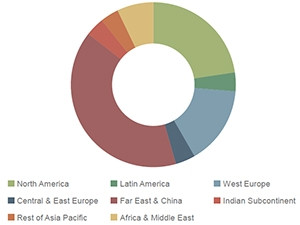
Digital commerce uptake is expected to exceed 40% of the global population by 2021, up from 32% in 2017.
This is according to a Juniper Research study, "Digital Commerce: Key Trends, Sectors & Forecasts 2017-2021", from Juniper Research, which found remote payments for digital and physical goods and digital banking via bill payment services sectors will dominate the global digital commerce industry, in terms of transaction values.
States the report: "These segments together will account for over half of global transaction values by 2021. Significant opportunity for businesses exists, with remote payments for digital and physical goods forecast to account for over 10% of the $20 trillion global retail market in 2017."
The study found the main drivers for the increase in remote payments for digital and physical goods include the changing habits of buyers and the increased preference for bots.
"For some time now, it has been clear that the mobile device, whether it be the smartphone or tablet, is becoming increasingly important in the world of e-commerce. Interestingly, Juniper has observed a shift in the market from a position where the smartphone was used as a means for discovery but not purchase, to a situation where the smartphone is used for both product discovery and purchase," explains Lauren Foye, senior research analyst and author at Juniper.
She adds the research also found chatbots and natural language search can greatly improve retailer understanding of consumer behaviour. "We are witnessing growth in this sector; for example, investment by Facebook and Google, as well as the launch of digital assistants by companies such as Amazon."
In SA, however, research firm World Wide Worx noted that for the first time since the dawn of e-commerce in the country, online retail in this country reached 1% of overall retail during 2016.
With regards to drivers for digital banking, the Juniper study found fewer people are visiting branches and are instead relying on mobile devices, "Banks' customers are not visiting their branches; in fact, the report also found that footfall has fallen by 10% per annum. The trend has seen banks move to a 'mobile first' approach."
In addition, the research discovered that digital banking will increasingly envelop a greater proportion of the global population, with adoption approaching one in two adults by 2021.
Locally, the four largest banking groups ? Absa, Nedbank, First National Bank and Standard Bank ? all have mobile banking apps, indicating the channels are gaining traction among citizens.
George Kalebaila, IDC senior manager for telecoms, media and Internet of things in Africa, says: "South Africa's banking industry is moving at pace with developed economies in terms of digital transformation, and we expect as the digital ecosystem matures, we will see more and more transactions and services move to the digital platforms, radically transforming the way we interact and conduct our lives. Mobility, without a doubt, is a key driver of this transformation, especially when applied in conjunction with other emerging technologies, such as the Internet of things, analytics, augmented/virtual reality and social media."
Share